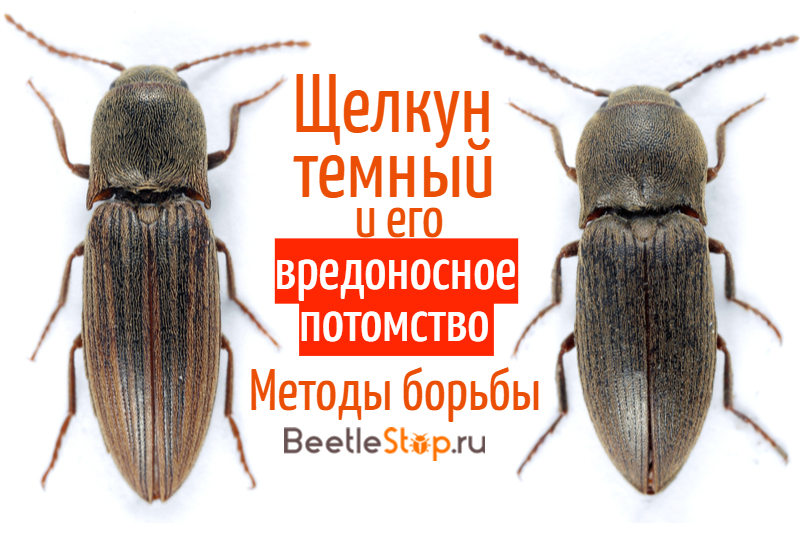The dark nutcracker - how to deal with wireworms on the field and in the garden
Nutcrackers - a family of about 12 thousand species. Beetles are spread all over the world, the most studied are the insects that live in the Palearctic. Their larvae, due to their specific appearance, were called stick insects. The nutcracker is one of the species harmful to agriculture. It spoils crops of corn and vegetable tuber crops. In the fight against bugs, agricultural measures and chemicals are used.

Morphological description of the species
Dark Nutcracker (Agriotes obscurus) is a member of the Nutcracker family. The body is wide, length 7-10 mm. The forehead is convex, eyes are round, antennae reach the end of the pronotum. From the fourth segment, the antennae are weakly sawtooth. The head is mobile, densely punctured. Pronotum transverse, strongly convex. Hind angles sharp. elytra with longitudinal grooves, sharply taper towards the apex. The upper part of the beetle is covered with gray hairs. Body color from brown-gray to black-brown. Extremities and antennae with a reddish tinge.
Information. Sexual dimorphism is weakly expressed, the female is slightly wider and larger, her antennae reach the middle of the pronotum.
Lifestyle and harmfulness
The dark nutcracker is widespread throughout Europe, its habitat extends to Siberia, captures the northern part of the Caucasus, Mongolia and Kazakhstan. The species was introduced to North America. Summer time depends on the region, in the steppe beetles appear in April, in the forest zone in May. Insects spend most of the day in moist, secluded places, hiding under the leaves. Active at dusk and in the early morning. Beetles fly well, move 50-200 m. Males are more mobile.
Interesting fact. Nutcrackers have a hopping mechanism that helps them roll over from back to legs. During jumps, a characteristic click is emitted.
Adults require additional nutrition before breeding. Dark nutcrackers gnaw parenchyma from cereal crops. Mating occurs on the soil. Favorable conditions for the ovipositor temperature + 18-25 °, humidity 80-90%. When humidity drops, egg laying ceases. To place the masonry, the female selects cereal fields or clover areas overgrown with wheatgrass. Eggs are laid in the soil in heaps of 5-10 pieces, fecundity is 75-200 pieces. The eggs are round, white with a diameter of 0.5 mm.
After 20-60 days, larvae appear. They are called sticks. The body is cylindrical, yellow or reddish-brown, glossy integument. The larva consists of a head, three thoracic and nine abdominal segments. The head capsule is reddish, it has a peephole, 3-segmented antennae, sickle-shaped mandibles with small teeth. Tergites of the chest and abdomen are covered with dots, wrinkles and bristles. The apex is short and wide. In length, wireworms grow to 25-28 mm, a width of 2 mm.
Larvae appear in late July. At the first age they are transparent, 1-2 mm long. offspring development lasts 3-5 years. During this time, 8-9 ages are replaced. Larvae feed on tubers and root crops, as well as other underground parts of plants. They damage potatoes, carrots, corn, and cereal grains. Larvae hibernate at a depth of 30-50 cm. They pupate at the end of summer. The dolly is white, similar to an imago.
Related view
Glittering nutcracker (Selatosomus aeneus) beetle 11-14 mm in size, omnivorous pest eating seeds, seedlings and root. Antennae dark red, limbs red-red. Adults lead an open lifestyle, active during the day. Females lay eggs in the soil in May-June, fertility up to 300 pieces. Adults feed on pollen and aphid excreta, sometimes eating insects themselves.
The larva develops in the soil for 2-4 years, molts 8-9 times. It harms seedlings of tomatoes, potatoes, corn. They prefer light soils and are found in forest litter. Larvae hibernate in soil at a depth of 30 cm. By the number of larvae per sq. fields offspring of a brilliant nutcracker takes first place.
Methods of struggle
Nutcracker larvae harm almost all agricultural plants. In the fight against them, the most effective are agrotechnical methods. The use of biological agents - ground beetles of the genera Calasoma and Carabus gives a good result.
Agrotechnical and mechanical methods
- Destruction of weed grass.
- Deep autumn plowing and row-spacing processing.
- Liming the soil and applying potash fertilizers.
- Crop rotation includes crops that wireworms do not like: millet, mustard.
- On valuable crops poisoned baits are placed.
Chemicals
As measures against wireworms, seedbed treatment with pyrethroids and organophosphorus compounds (Vulcan, Prestige, Semaphore) is recommended. Insecticides and neonicotinoids (Aktara, Barguzin, Prestige) are introduced into the soil.

